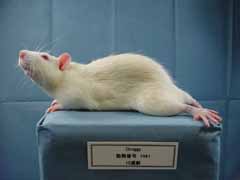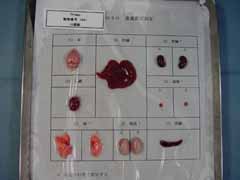| NBRP Rat No: 0368 |
Strain name: GRY/Idr |
Commmon Name: GRY, groggy rat |
Rat Genome Database |
| Principal Investigator: |
Tadao Serikawa Graduate School of Medicine, Kyoto University Yoshidakonoe-cho, Sakyo-ku 606-8501 Kyoto JAPAN |
| Tel: 075-753-4360 Fax: 075-753-4409 |
Email: serikawa@anim.med.kyoto-u.ac.jp |
| Preservation Status: |
Embryo Sperm Living Animals |
 |
 |
| Coat Color |
albino (c) |
| Inbred Generations |
F40+21 (March 2012) |
| Usage Restrictions |
The recipient of BIOLOGICAL RESOURCE shall obtain a prior written consent on use of it from the DEPOSITOR.
For a commercial use of this resource, a new contract must be concluded between the depositor and the recipient. |
| Genetic Status |
|
| Comercial Availability |
|
|
| Research Category |
|
| Gene Affected |
Cacna1a: calcium channel, voltage-dependent, P/Q type, alpha 1A subunit |
| Origin |
The rat displaying abnormal movement was established from a progeny of a Slc:Wistar female had been given by methylnitrosourea at early stage of the gestational period in the Institute for Developmental Research, Aichi Human Service Center in 1991 (Takeuchi, 1991). This character is inherited by an autosomal single recessive gene. (Oct 28, 2010) |
| Strain characteristics |
GRY rats show movement disorder, ataxia, and an unstable gait from postnatal day 15 (Takeuchi, 1991). They also show paroxysmal severe extension of the body and limbs. The causative mutation has been named groggy (gry). The size of cerebellum is reduced in mature rats. Histologically, abnormalities of Purkinje cells, neuron degeneration in the striatum and septum atrophy are recognized (Takeuchi, 1994; Takeuchi, 1995; Takeuchi, 2002). GRY rats exhibit absence-like seizure from 6 to 8 weeks of age, which were characterized by bilateral and synchronous 7-8 Hz spike-and-wave discharges concomitant with sudden immobility and staring (Tokuda, 2007). The gry mutation was mapped on rat chromosome 19 and found as a nonconservative missense (M251K) mutation in the Cacna1a gene (Tokuda, 2007). Some antiepileptic drugs (AED) display inhibitory effects on absence seizure in GRY rats (Tokuda, 2007; Tokuda, 2010; Ohno, 2010). (Oct 28, 2010) |
| Breeding Conditions |
Good breeding performance. |
| Genotyping |
Genotyping protocol for Cacna1a |
| References |
Mizuno-Iijima S, Kawamoto S, Asano M, Mashimo T, Wakana S, Nakamura K, Nishijima KI, Okamoto H, Saito K, Yoshina S, Miwa Y, Nakamura Y, Ohkuma M, Yoshiki A.
Mammalian genome research resources available from the National BioResource Project in Japan.
Mamm Genome. 2024 Dec;35(4):497-523.
Ohmori I, Kobayashi K, Ouchida M.
Scn1a and Cacna1a mutations mutually alter their original phenotypes in rats.
Neurochem Int. 2020 Dec:141:104859.
Kawakami N, Kobayashi K, Nishimura A, Ohmori I.
Poor mother-offspring relationships in rats with Cacna1a mutation.
Exp Anim. 2020 Apr 24;69(2):153-160.
Takeuchi IK, Takeuchi YK.
Neuronal degeneration in the striatum of the groggy rat: a new mutant with a movement disorder.
Experientia. 1991 Dec 1;47(11-12):1215-8.
Takeuchi IK, Aoki E, Takeuchi YK.
Age-related and region-specific increase in number of concentric lamellar bodies in axon terminals and presynaptic axons in central nervous system of groggy mutant rat.
Acta Neuropathol. 1994;87(6):628-34.
Takeuchi IK, Aoki E, Takeuchi YK.
Axonal swellings in cerebellar white matter of groggy mutant rat.
Acta Neuropathol. 1995;90(5):486-92.
Takeuchi IK, Aoki E, Takeuchi YK.
Concentric lamellar bodies in axon terminals and preterminal axons of cerebellar Purkinje cells in groggy mutant rat: acid phosphatase cytochemistry.
J Electron Microsc (Tokyo). 1995 Jun;44(3):140-4.
Takeuchi YK, Takeuchi IK.
Neuronal degeneration in the septum of the groggy mutant rat.
Gifu College Med. 2002, 18.
Tanaka K, Shirakawa H, Okada K, Konno M, Nakagawa T, Serikawa T, Kaneko S.
Increased Ca2+ channel currents in cerebellar Purkinje cells of the ataxic groggy rat.
Neurosci Lett. 2007 Oct 16;426(2):75-80.
Tokuda S, Kuramoto T, Tanaka K, Kaneko S, Takeuchi IK, Sasa M, Serikawa T.
The ataxic groggy rat has a missense mutation in the P/Q-type voltage-gated Ca2+ channel alpha1A subunit gene and exhibits absence seizures.
Brain Res. 2007 Feb 16;1133(1):168-77.
Tokuda S, Sofue N, Ohno Y, Sasa M, Serikawa T.
Inhibitory effects of levetiracetam on absence seizures in a novel absence-like epilepsy animal model, Groggy rat.
Brain Res. 2010 Nov 4;1359:298-303.
Ohno Y, Sofue N, Imaoku T, Morishita E, Kumafuji K, Sasa M, Serikawa T.
Serotonergic modulation of absence-like seizures in groggy rats: a novel rat model of absence epilepsy.
J Pharmacol Sci. 2010 Sep 16;114(1):99-105.
Kuramoto T, Nakanishi S, Ochiai M, Nakagama H, Voigt B, Serikawa T.
Origins of Albino and Hooded Rats: Implications from Molecular Genetic Analysis across Modern Laboratory Rat Strains.
PLoS One. 2012;7(8):e43059.
Yuya Harada, Yuki Nagao, Takahiro Mukai, Saki Shimizu, Kentaro Tokudome, Naofumi Kunisawa, Tadao Serikawa, Masashi Sasa, Yukihiro Ohno.
Expressional Analysis of Inwardly Rectifying Kir4.1 Channels in Groggy Rats, a Rat Model of Absence Seizures.
Archives of Neuroscience. 2014 october; 1(3): e18651
Serikawa T, Mashimo T, Kuramoto T, Voigt B, Ohno Y, Sasa M.
Advances on Genetic Rat Models of Epilepsy.
Exp Anim. 64(1):1-7, 2015. |
| Additional strain information |
|
|
|